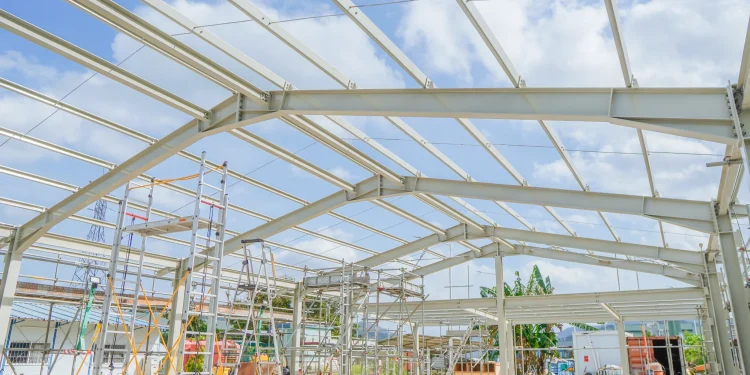Planning to build a chicken slaughterhouse? There are several standards you need to pay attention to. First, a chicken slaughterhouse must comply with hygiene and health standards, focusing on the use of non-toxic, waterproof, and anti-fungal materials for walls, floors, and ceilings. The floor should be corrosion-resistant, non-slip, waterproof, and crack-resistant, while the ventilation system must ensure proper air circulation.
Next, the construction of a chicken slaughterhouse should use durable and easy-to-maintain materials. The building design should also allow clear separation between clean and dirty areas. Moreover, the structure must prevent pests, rats, insects, birds, and other animals from entering the building, while also facilitating the cleaning and disinfection process.
This is where portal frame steel construction meets the required standards for building a chicken slaughterhouse. In brief, a portal frame is a rigid structural framework composed of vertical H-beam steel columns connected to rafter beams.
Portal frame steel construction is ideal for chicken slaughterhouses with wide-span designs, as it provides large open spaces without the need for many columns in the central area. This wide space aligns with slaughterhouse standards that require distinct areas for clean and dirty zones.
The structure uses corrosion-resistant steel that has undergone a hot-dip galvanizing process, in which the steel is coated with zinc by being submerged in a high-temperature bath. This anti-rust steel strengthens the structure, ensuring the building stands firm and lasts for many years.
Portal frame steel construction is also suitable for other types of facilities, including warehouses, storage facilities, factories, hangars, gymnasiums, workshops, and both livestock and chicken slaughterhouses.
For reliable steel construction services, you can trust Tradecorp. Since 2014, Tradecorp has supported various business and field operations by providing shipping containers, offshore DNV containers, ISO tank containers, modified containers, modular prefabricated buildings, and RapidFrame construction.
As proof of its capability, Tradecorp has been involved in major projects such as constructing mining accommodation facilities in Sumatra and Kalimantan, supplying infrastructure for the 2018 Asian Games, and supporting the Formula E Jakarta event, and recently, the construction of operational facilities in mining areas using portal frame steel structures.
If you’re planning to build a chicken slaughterhouse, our team is ready to help calculate the estimated cost and adjust the design according to your requirements. You can contact Tradecorp directly by filling out the online form available at https://kontainerindonesia.co.id/en/. Our team will then discuss your needs and assist in estimating the project cost.
Want to learn more about portal frame steel construction for chicken slaughterhouses? Check out the detailed information in the following sections!
Portal Frame Steel Construction Design for a Chicken Slaughterhouse
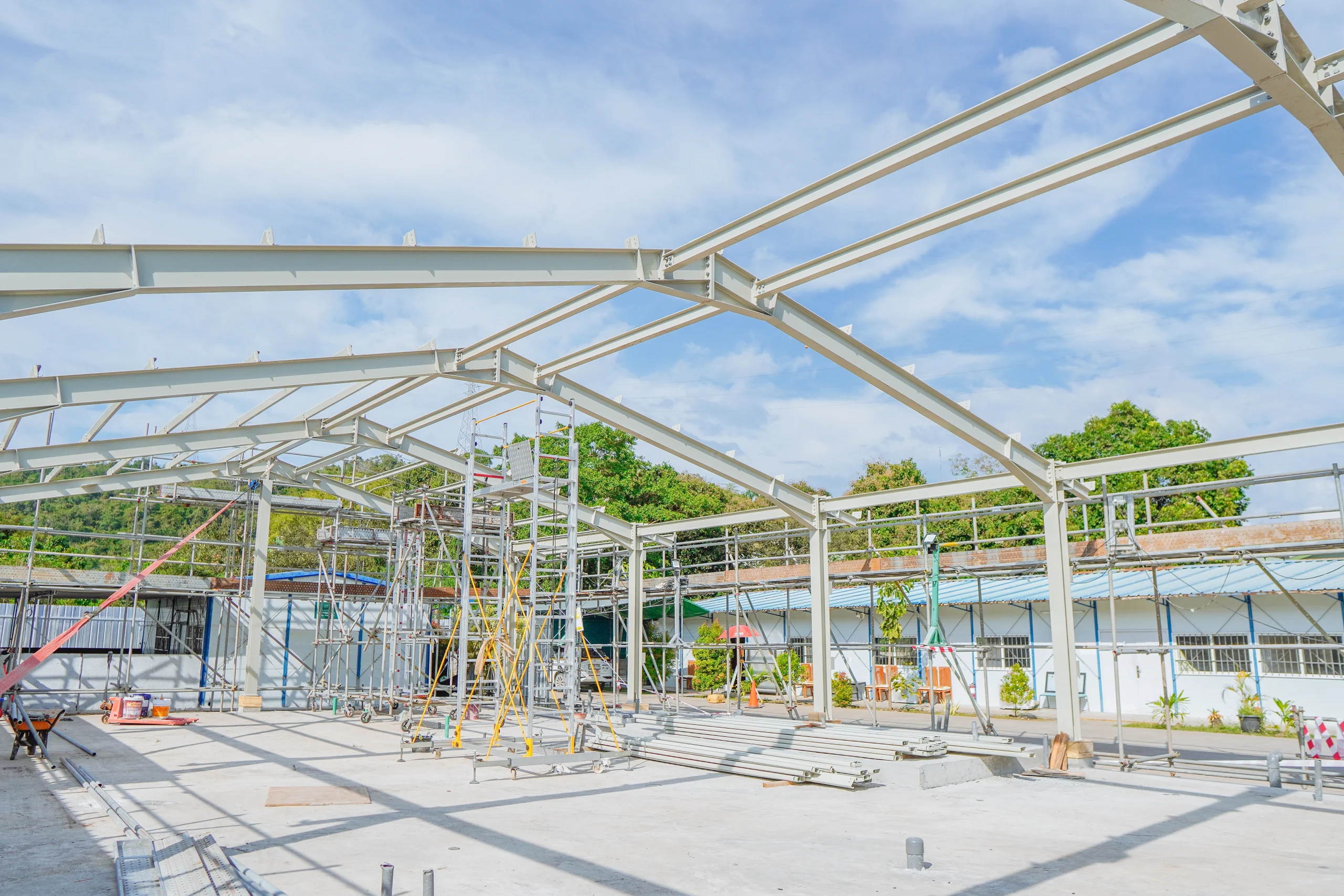
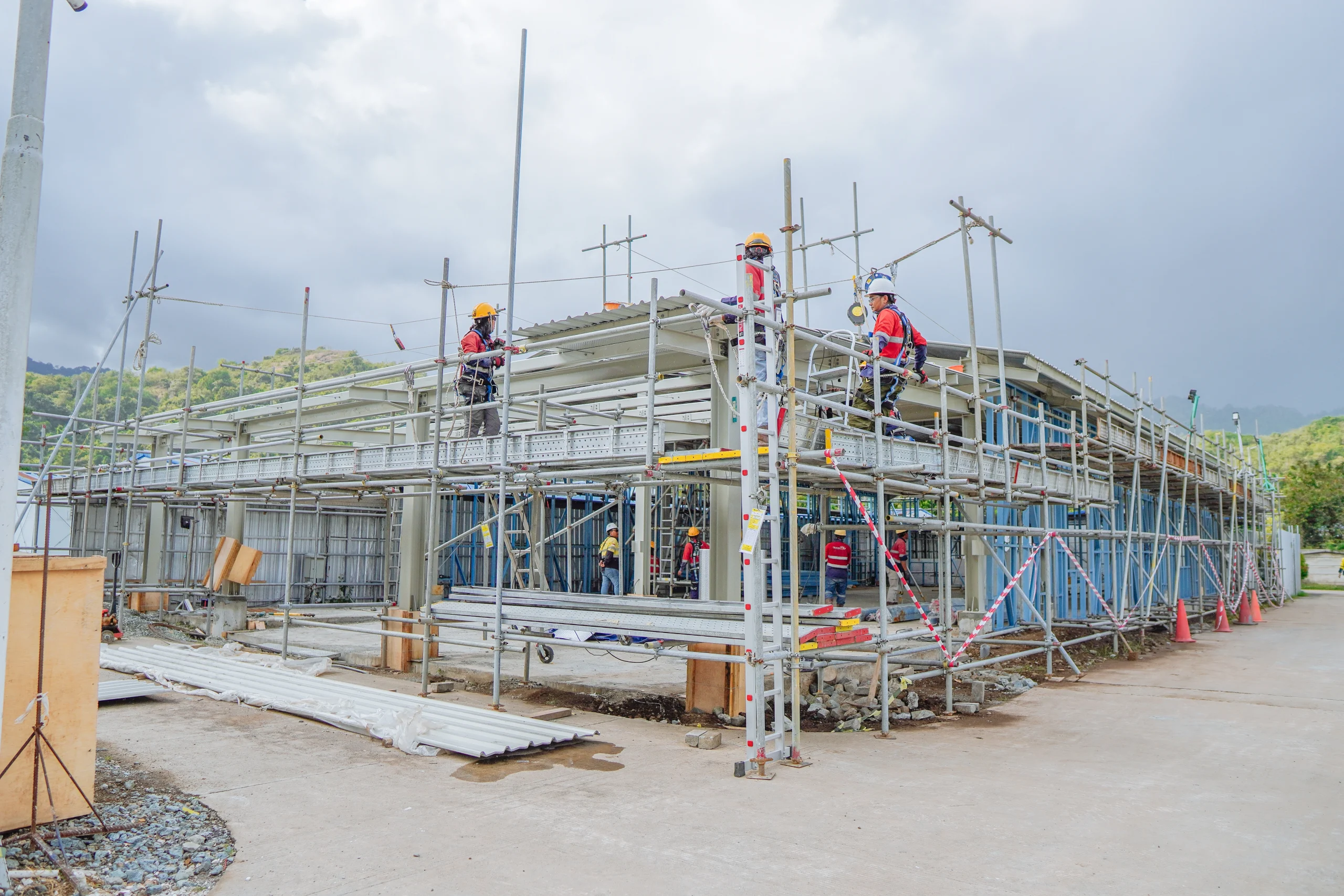

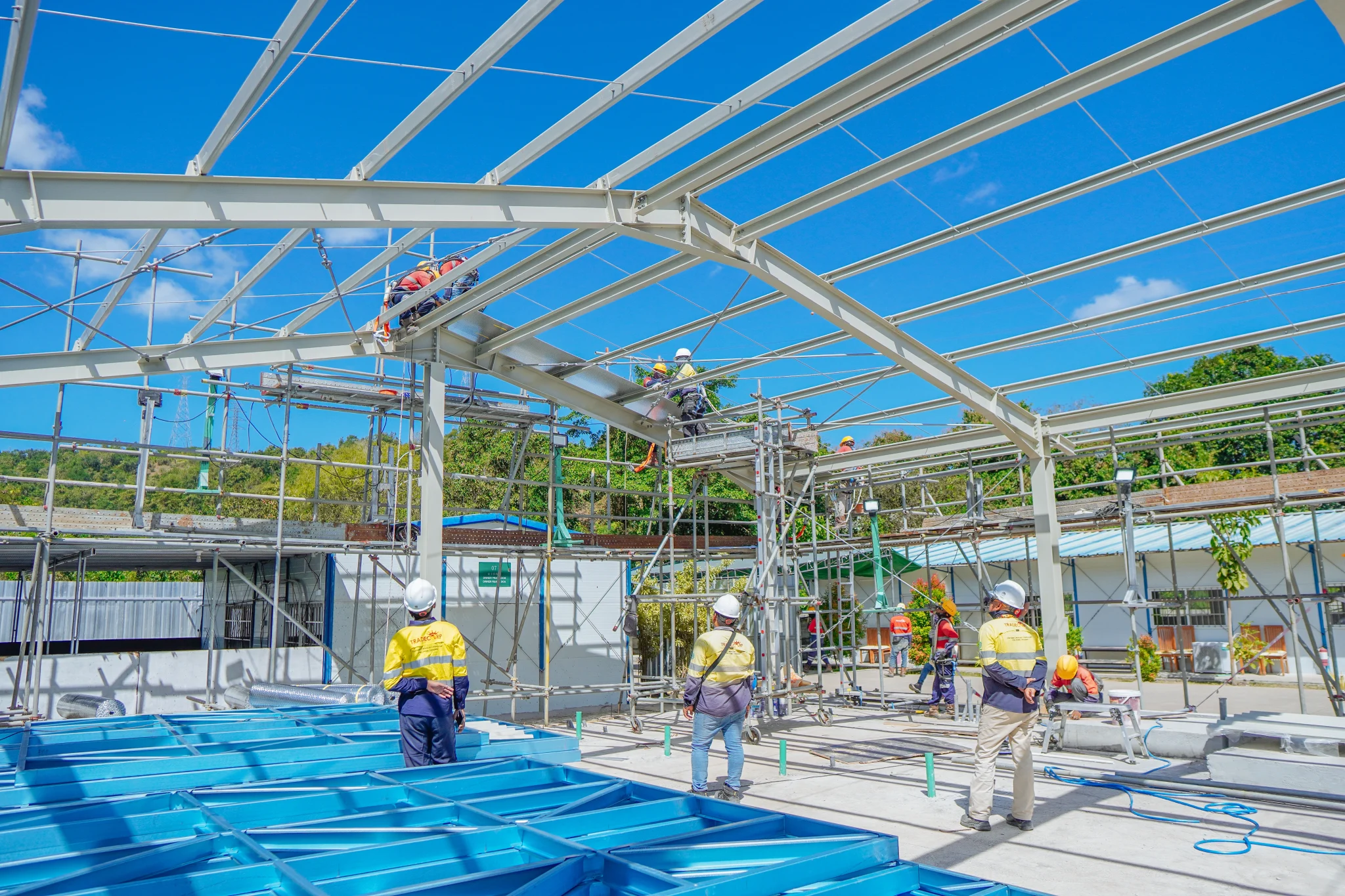
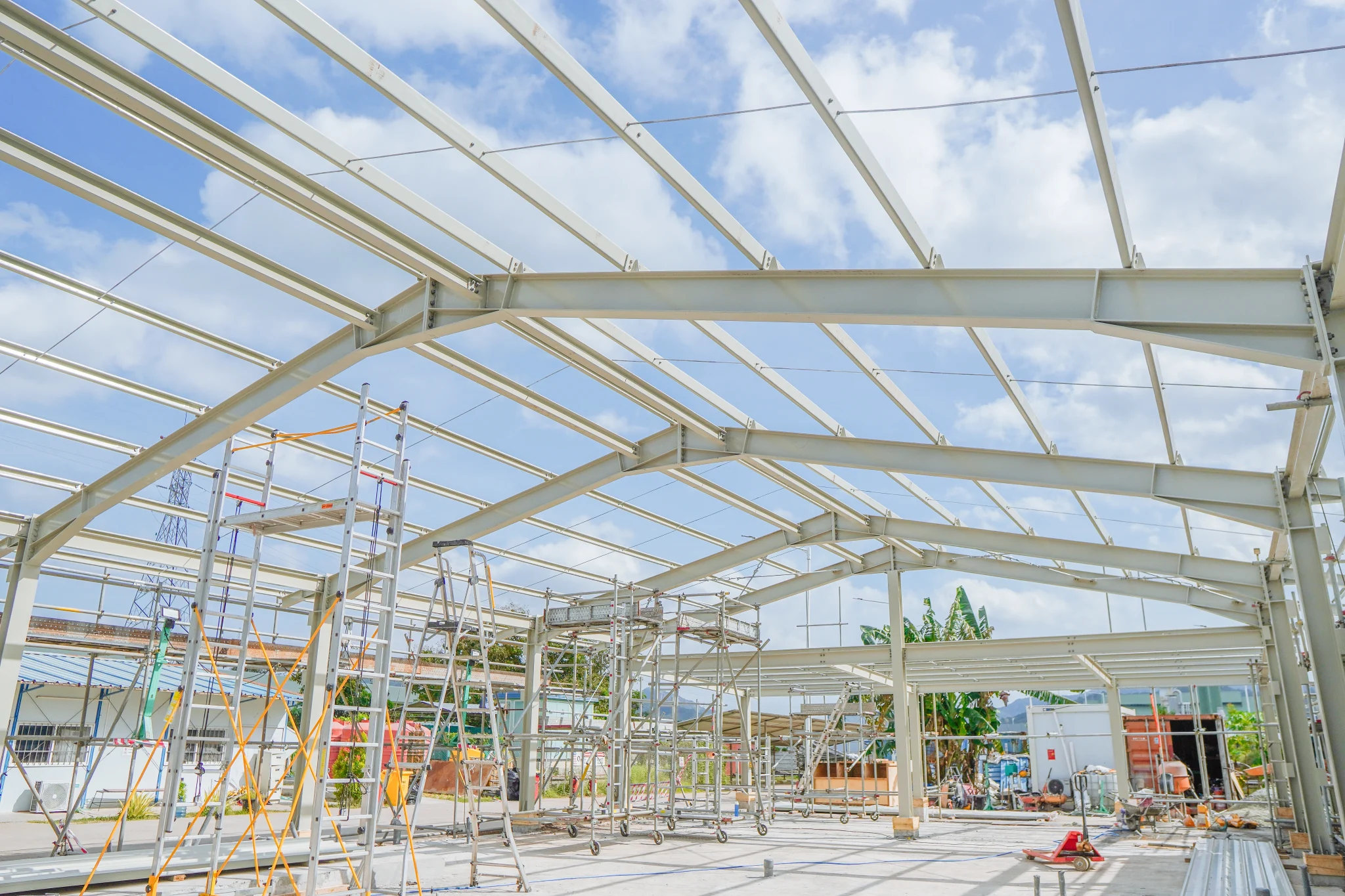
The Best Option for Chicken Slaughterhouse
Advantages of Portal Frame Steel Construction
Portal frame steel construction offers many advantages, making it one of the best options for industrial buildings, warehouses, and chicken slaughterhouses. Here are some of its key benefits.
1. Wide Column Free Space
The portal frame structure is designed to create a wide span without multiple columns in the center area. This design allows for a more flexible and functional layout, making it ideal for warehouses, workshops, hangars, or large scale production facilities. The working and storage areas can be fully optimized without structural barriers in the middle of the building.
2. Strength Supported by Premium Materials
Made from high quality steel coated with anti corrosion protection, portal frame construction provides excellent resistance to heavy loads, strong winds, and extreme weather conditions. The structure is also resistant to corrosion and pest interference, resulting in a longer lifespan with minimal maintenance needs.
3. Cost and Material Efficiency
The portal frame system is efficient in material use because the fabrication and assembly process is streamlined. Its lightweight structure allows the use of a simpler foundation, making the overall construction cost more economical. The short installation period also helps reduce labor costs on site.
4. Fast and Practical Construction Process
Components of the portal frame steel structure are usually prefabricated in factories with high precision and then delivered to the site for assembly. This method accelerates the construction process and minimizes the risk of on site errors, making it a suitable choice for projects with strict deadlines.
5. Environmentally Friendly and Sustainable
Steel is a recyclable material that can be reused almost indefinitely. The use of portal frame construction helps reduce construction waste and supports the implementation of environmentally friendly and sustainable building practices.
6. Flexible for Various Designs and Requirements
The steel portal frame structure can be easily adjusted to different building designs, including roof shape, room layout, and the type of wall and roof panels used. The structure also allows for future expansion or modification without dismantling the entire building, making it ideal for growing businesses such as chicken slaughterhouses that may need to expand their operations over time.
The Best Option for Chicken Slaughterhouse
Essential Equipment in a Chicken Slaughterhouse
To maintain the chicken slaughtering process in a hygienic, efficient, and food safety–compliant manner, a chicken slaughterhouse must be equipped with proper standardized equipment. Below are the essential tools and machinery that should be available in a chicken slaughterhouse.
1. Hygienic Knives and Cutting Tools
Knives are the most vital tools in the slaughtering and cutting process. Each knife must be made from food grade stainless steel to ensure rust resistance and easy sterilization. The sharpness should be maintained regularly, and separate knives should be used for clean and dirty processing areas to prevent cross contamination.
2. Cutting Tables or Boards
Cutting tables should be made from non porous materials such as stainless steel, rather than wood, since wood absorbs fluids and can harbor bacteria. The surface should be designed for easy cleaning and without gaps that could trap meat residues or blood.
3. Clean Water Tanks and Washing Systems
Clean water tanks are used for washing chickens after the feather removal stage. The water should flow continuously to maintain cleanliness and prevent dirt buildup. In modern chicken slaughterhouses, the washing system often includes stainless steel spray nozzles that improve water efficiency and provide even cleaning results.
4. Automatic Feather Plucking Machine
This machine speeds up the feather removal process and provides more consistent results compared to manual methods. Modern feather plucking machines are equipped with automatic waste disposal systems to keep the working area clean and hygienic.
5. Hot Water Boilers or Heating Tanks
Hot water is used during the scalding stage to loosen the chicken’s skin pores before feather removal. For industrial scale operations, automatic stainless steel heating tanks are recommended instead of conventional pots because they allow stable temperature control for greater efficiency and uniform results.
6. Electric Chicken Cutting Machine
An electric chicken cutter helps increase production capacity with faster cutting times and consistent results. This equipment is highly effective for medium to large scale operations but must be cleaned regularly to ensure hygiene and safety.
7. Digital Scales
Scales are used to ensure the product weight meets the required standard or customer order. Digital scales are more accurate and efficient than manual ones, and they can be calibrated regularly to maintain precision during packaging and distribution.
8. Conveyor System
A conveyor system helps transport chickens from one processing stage to another without direct human contact. Besides improving speed and workflow efficiency, it also helps maintain hygiene standards within the chicken slaughterhouse facility.


